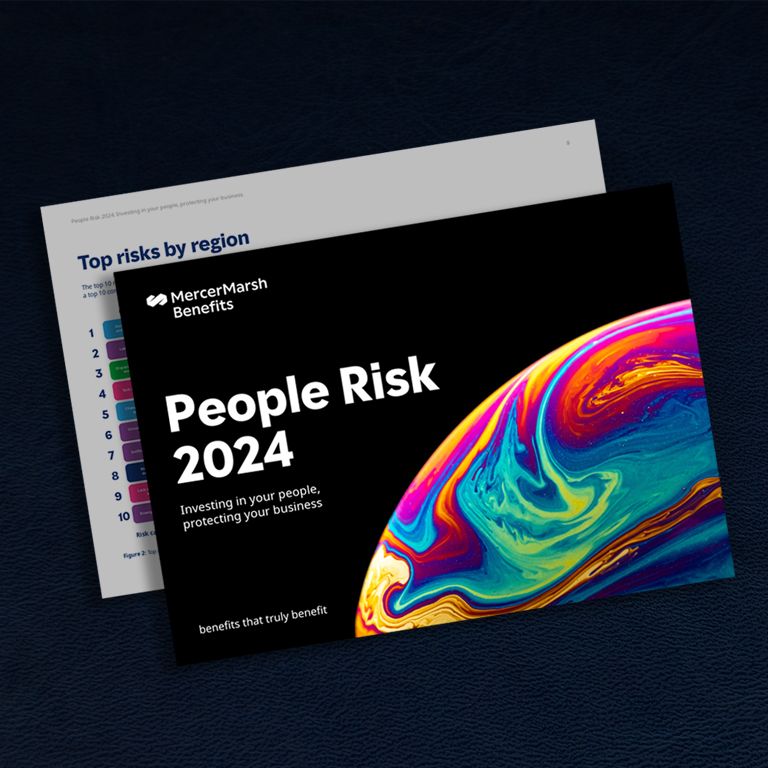By, David Stark and Helena Zikova ,
13/07/2022 · 6 min read
The past few years have been tough on organizations, but important lessons have been learned. It is clearer than ever that business resilience is intrinsically linked to the health and well-being of the workforce.
Now, the test for firms is to take those learnings and make wholesale changes to how they operate, rather than revert to “business as usual”. Employees expect more from their organizations with a global economic crisis and the ongoing war for talent.
The consequences of getting this wrong are significant, as evidenced by our People Risk Report 2022. We found that the greatest risks facing firms are cybersecurity and privacy, administration and fiduciary, and catastrophic personal life events.
Firms need to ask themselves: “Can we give people more security, flexibility, and better health while also facing up to the business challenges of lowering costs, navigating operational disruption, and increasing liquidity?”
The answer is yes, but only for those organizations that get the basics right and ensure they have strong ERM practices in place.
In addition, research conducted by Marsh in 2021 on risk information published within the annual reports and accounts by organizations listed on the FTSE100, Euronext, NYSE, and HKSE suggests there is a need for an increased focus on ESG risks in many organizations. Results point to a concentration across all exchanges on the environmental aspect of ESG evaluation and less attention to its social and governance facets. It is vital that companies’ strategies to mitigate ESG risks consider social and governance as well as environmental factors, to ensure their long-term value and resilience.
Building trust among employees and wider stakeholders, including customers, is an important part of the puzzle. Our wider research shows that employer responses during the pandemic impacted staff sentiment. In an era of heightened awareness of ESG issues, companies must work harder to earn the trust of employees, customers, investors, and regulators.
Organizational complexity is a high barrier for every pillar of people risk. As businesses continue to grow and threats are present across traditionally siloed work areas, organizations are struggling to define who is responsible for owning a particular mitigation effort, thus leading to gaps in adequately addressing looming risks.
HR and risk managers must therefore work together. Fortunately, the People Risk Report 2022 research shows a strong alignment between these groups when it comes to the top issues facing businesses. Now, organizations should capitalize on this alignment and continue to break down siloes to further enhance collaboration on risk identification and mitigation.
Difficulties that change personal behaviors are also identified as a key barrier. For this reason, it is critical to develop an ERM culture. Risk culture is built on a foundation of shared organizational values, attitudes, and behaviors, with visible and accountable leadership, backed up by shared responsibilities and actions by all members of staff. Risks present both threats and opportunities, so a multi-disciplinary, deliberate, and well-coordinated approach is needed to help develop effective measures that mitigate threats and take opportunities.
Our Age of Adaptability report indicates that 88% of HR teams have seen more involvement in benefits from the C-suite. Risk managers and HR teams therefore must take their disciplines to the next level.
This means developing more deliberate approaches to listening to employees, a tighter connection between benefits and business goals, and judicious cost management focused on value and multi-year benefit strategies. Some are tweaking values and cultures to promote human-centric leadership, justice, and purpose. With ESG on the rise, many organizations are looking to build a sustainable people culture, including delivering on total well-being. In this scenario, it will be more challenging to make cuts to benefits as many have done in the past, to keep benefit budgets affordable. Hence, cost management instead of cost-shifting to employees is needed; for example, steering employees through plan design to higher-quality points of care to reduce complications, or using virtual care when appropriate.
For HR or risk professionals just starting to acquaint themselves with the discipline of their respective HR or risk counterpart, here are some possible conversation topics to get started on identification opportunities.
All of the top ten risks identified by HR and risk managers globally can be mitigated by employee benefits and other support programs (or by how they are designed and delivered). Firms need to make sure that they have the right support in place and that they’re delivered appropriately. An ERM approach can be applied to all people risks to build organizational resilience and agility.

Consulting Director & Practice Leader of Enterprise Risk Services
United Kingdom

Sales Leader, Continental Europe, Mercer Marsh Benefits
Austria

Report
22/04/2024